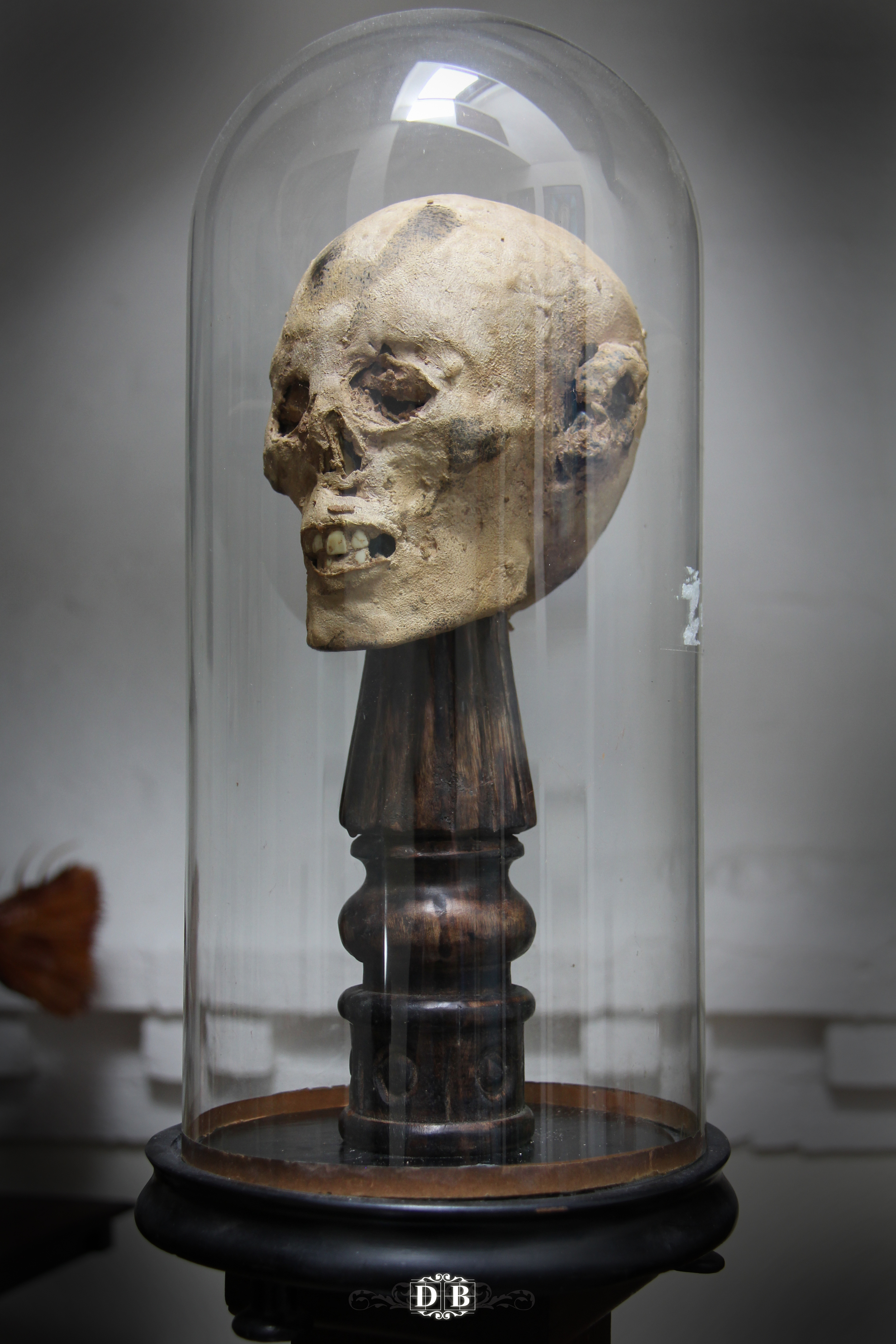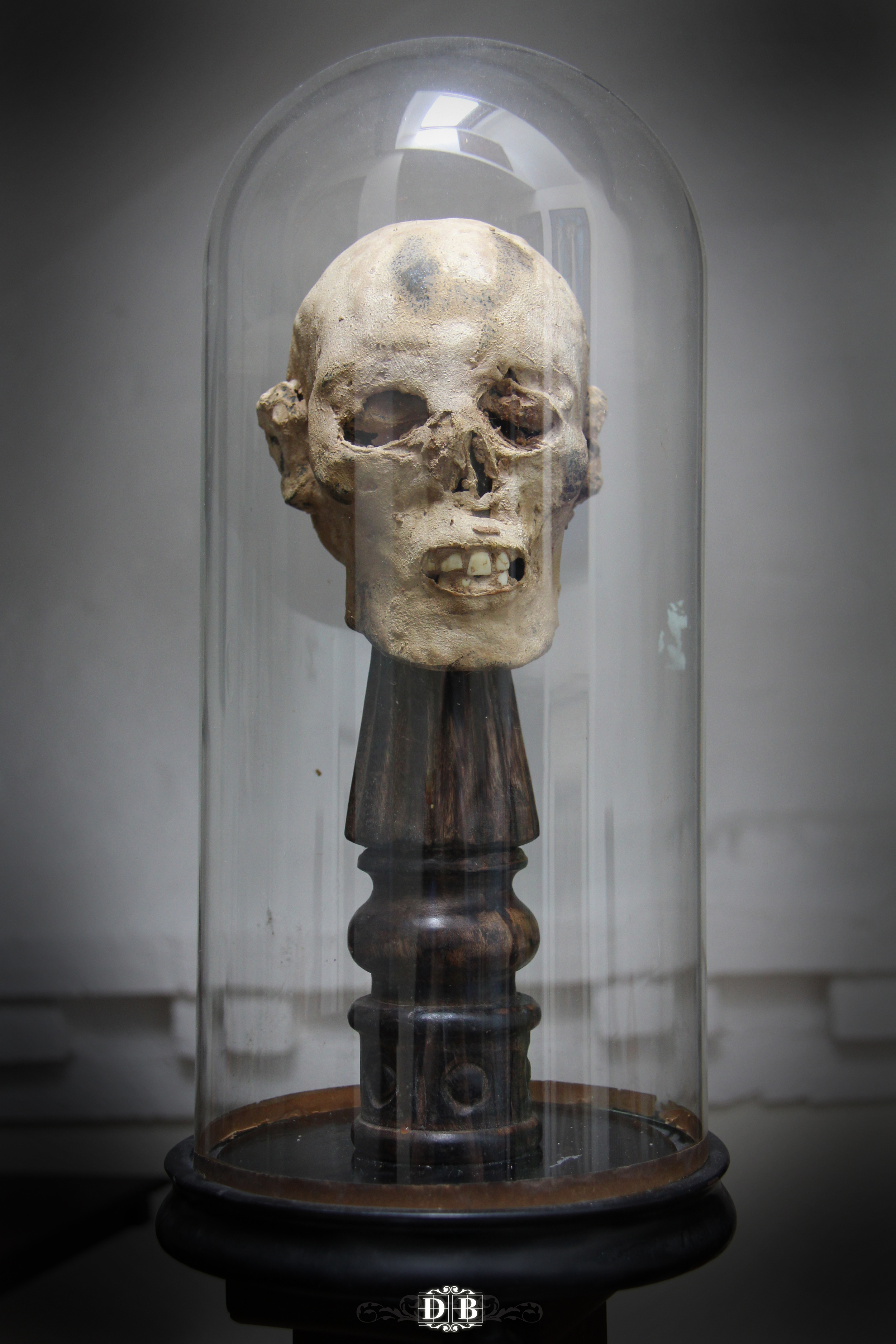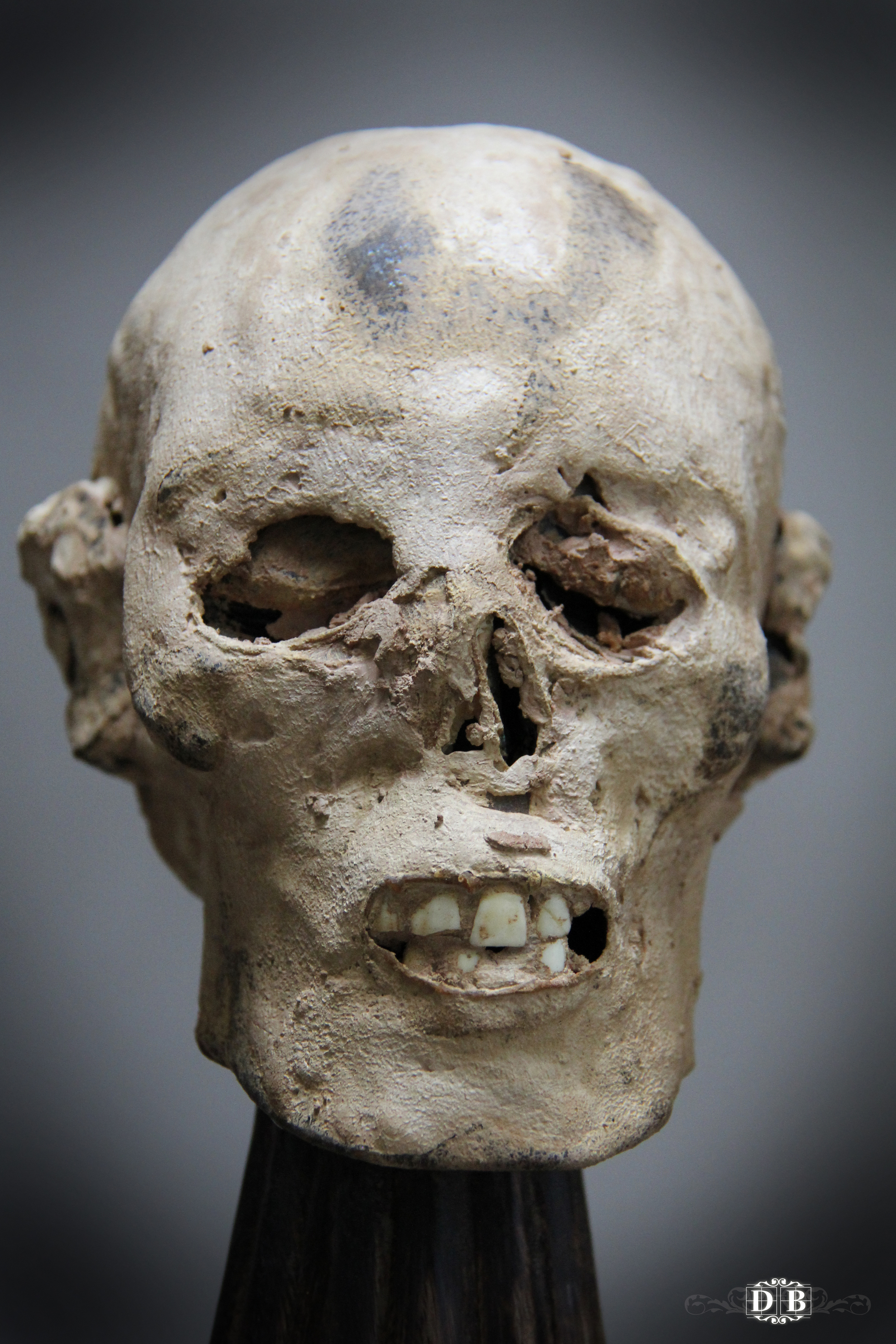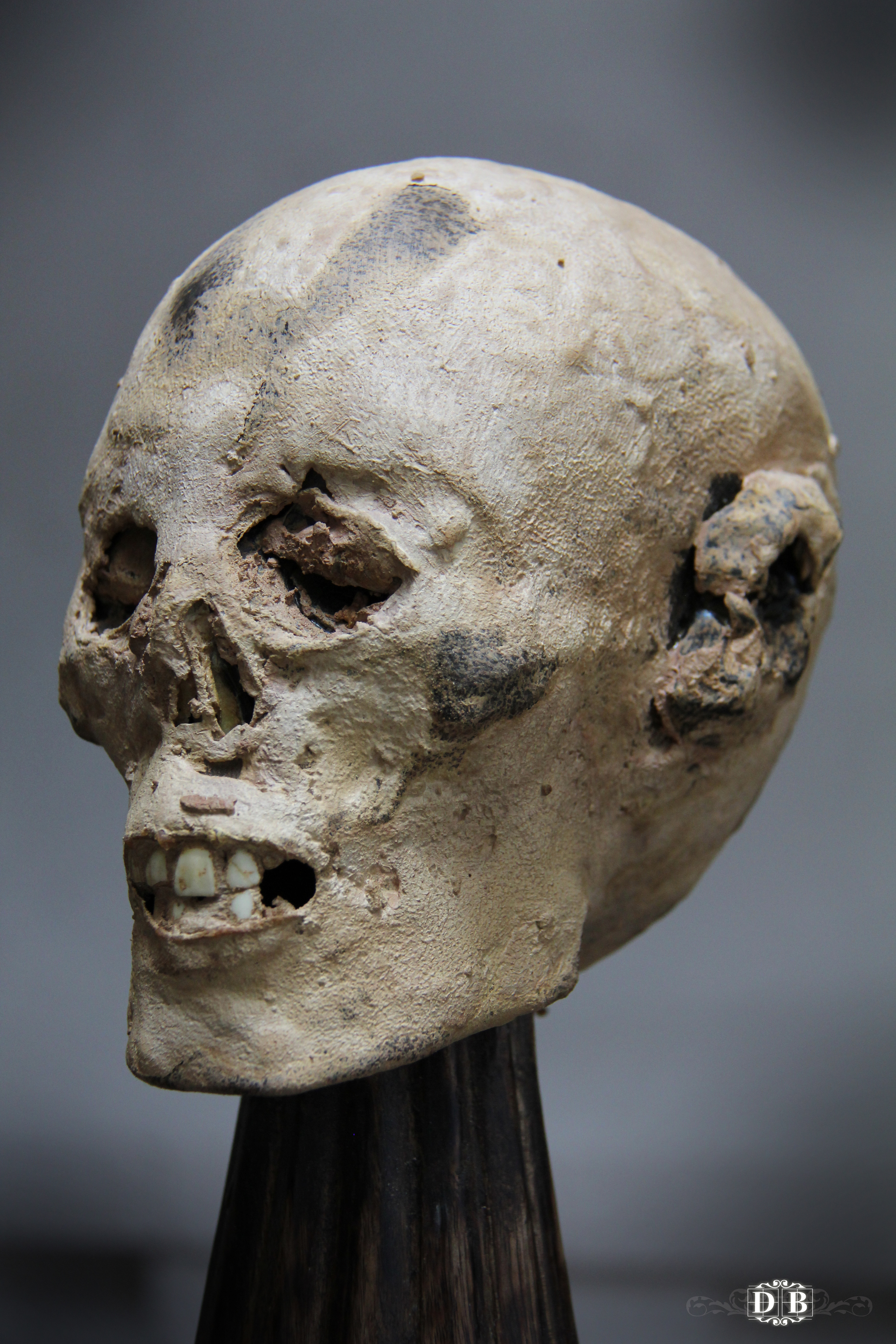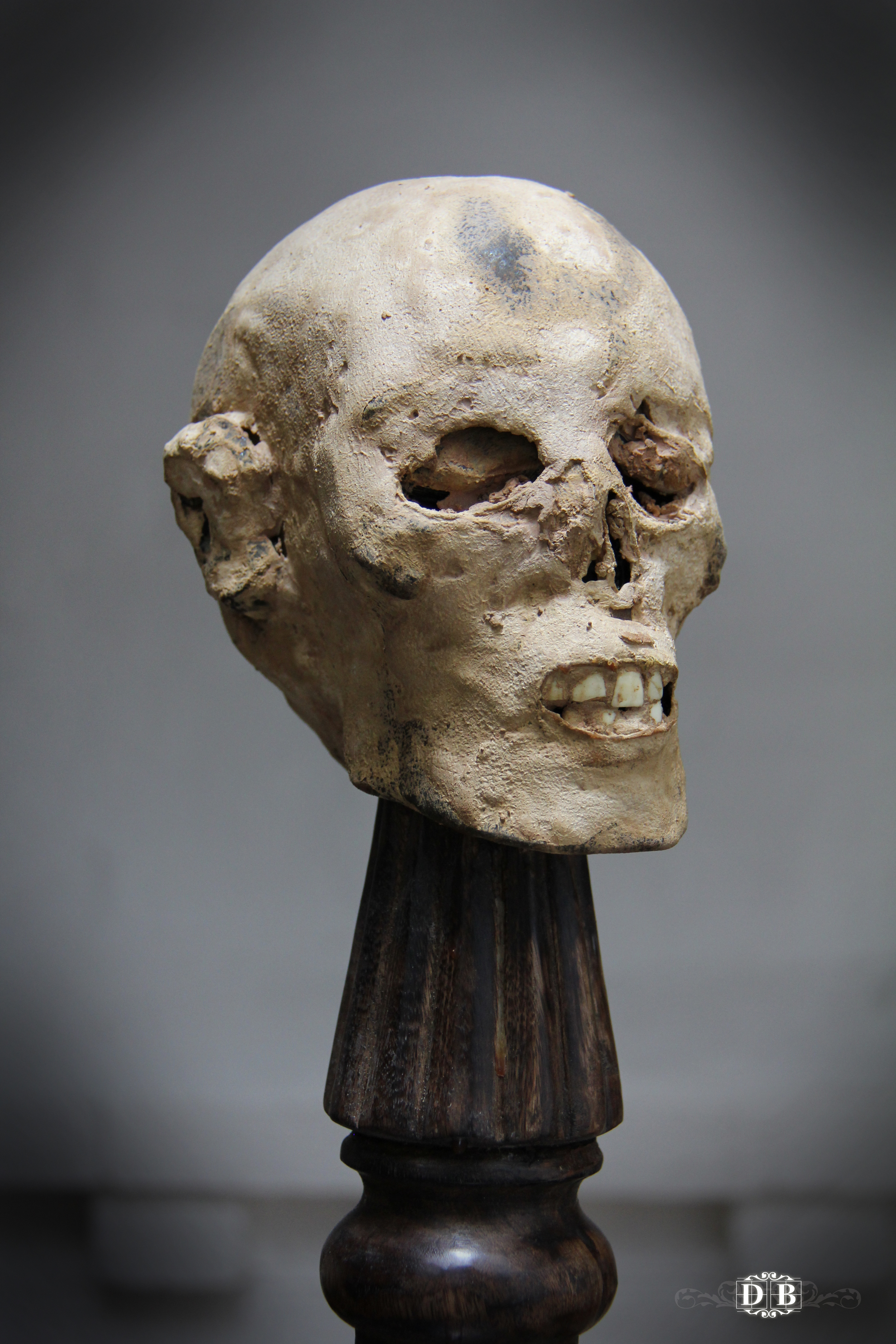mummified head I
Our strange tale begins not in the arid deserts of Egypt but over two thousand miles away in Blackpool, the popular seaside resort on the east coast of England.
This booming Victorian holiday retreat with its fortune tellers, public houses, trams, fish & chip shops and theatres was and still is home to one of the UK’s most popular tourist attractions – the Pleasure Beach.
It is here that in 1930 the world’s first ever dark ride to use the name ‘Ghost Train’ was opened. Preying on the human fascination with fear the popularity of the ride was huge and soon other amusement parks around the country installed similar rides. Even holiday camp king Billy Butlin installed ghost trains in each of his seaside amusement parks.
However in 1936, Blackpool Pleasure Beach decided to install an even larger ghost train and commissioned Joseph Emberton, a top London architect to design it. It had a lavishly impressive frontage, opening up into a giant horror themed stage set, complete with a roller coaster-style drop in the centre. After 14 years of almost continual use the Ghost Train was closed for a much needed renovation and it was then, in 1950, that something remarkable yet unsettling was discovered.
As the numerous papier-mâché skeletons, witches and demons were carefully removed; a maintenance worker noticed that one unusual prop stood out amongst the others. During a section of the ride the spectator would see a beautiful woman combing her hair in a mirror only for her reflection to slowly metamorphosize into a decomposed corpse. It is this ‘corpse’ that grabbed his attention. In broad daylight it could be seen that this strangely mounted head and shoulders was not a crudely made papier-mâché prop but in fact real human remains. The question is who’s were they, how did they get there and why were they hidden in one of the country’s top theme park attractions?
To uncover the mystery of the head we need to go back to 1922 and Howard Carter’s excavation of Tutankhamen’s Tomb in the Valley of the Kings. The clearance of the tomb with its thousands of artefacts took 10 years, yet even with Carter’s modern archaeological methods and systems of recording the odd desirable object was bound to go astray. Carter’s journal noted that on the 17th July 1924 a small sarcophagus was removed still sealed and intact. Hieroglyphics on the lid were translated and it was ascertained that it contained ‘Skurotep – high prophet and spiritual advisor to the boy king Tutankhamen’. Yet between the Valley of the Kings and Cairo the precious cargo containing Skurotep was
intercepted. The drivers had been shot and the sarcophagus was opened. Carter discovered that only the head and shoulders of the Skurotep mummy had been taken. Even the gold artefacts that accompanied the sarcophagus had not been stolen. It was apparent that
the head of Skurotep was very important to somebody but why?
After further research Carter discovered through ancient Egyptian folklore that the head of a powerful prophet was considered magical. Through records from previous excavations he found striking similarities in the desecration of other sarcophagi said to have contained
prophets and priests.
Priests were the main practitioners of magic in pharaonic Egypt, where they were seen as guardians of secret knowledge given by the gods to humanity to 'ward off the blows of fate'. The most respected users of magic were the lector priests, who could read the ancient books of magic kept in temple and palace libraries. In popular stories such men were credited with the power to bring wax animals to life, or roll back the waters of a lake.
It was thought that by owning the mummified head of one of these priests one could possess the magical knowledge and power the priest once held. As a result grave robbers and bandits would be employed by unknown clients to retrieve these heads. It is even speculated that Hitler owned at least two Egyptian ‘heads of prophecy’.
Like the Golem of Praque from Czech legend it was believed that its power could be activated by a ritual in which a piece of parchment was inserted either in the mouth or in the head of the mummy, thus bringing it into life and action. Unlike the Golem, the head of the mummy would not reanimate however the ancient spirit would be called from the ‘field of reeds’ or Aaru – the Egyptian afterlife to perform the task written on the parchment set by the master of the head.
The head of Skurotep of Skurot as it became known vanished for 3 years only to mysteriously reappear, like most Egyptian relics, in London in 1928 however, not in a museum but in a sideshow auction.
Tom Norman, also known as ‘The Silver King’ was an English businessman and Showman of human oddities, otherwise known as ‘Freak shows’. Probably the most famous of his ‘exhibits’ was John Merrick ‘The Elephant Man’. Norman's travelling exhibitions also featured Eliza Jenkins, the "Skeleton Woman", a "Balloon Headed Baby" and a woman who bit off the heads of live rats—the "most gruesome" act Norman claimed to have seen. He quickly became successful with 13 ‘Penny Gaff’ shops in London alone. Consequently Norman ran into a shortage of curiosities and travelled the country looking for new acts and exhibits enticing human novelties with promises of generous salaries. As he stated in his autobiography "you could indeed exhibit anything in those days. Yes anything from a needle to an anchor, a flea to an elephant, a bloater you could exhibit as a whale. It was not the show; it was the tale that you told.”
During the summer of 1928 in Norman’s Shoreditch Penny Gaff Shop a new attraction was opened. ‘Vadoma The Mummified Genie’ was pitched as an exhibit that could grant ones wish from beyond the grave. Although it is not known who Norman purchased the head from it is reported that its power was ‘demonstrated’ to him and he was so anxious to own the exhibit he cashed in a considerable percentage of his retirement savings.
‘Vadoma’ was only marketed by word of mouth from the Shoreditch shop to people of considerable wealth. Hidden in a small back room the client would part with a large sum of money equating to £500 in today’s money and be given the choice of a wish or a vision of the future. The client then wrote their choice on a slip of paper which was then placed somewhere on the head. As to whether ‘Vadoma’ actually granted these wishes or visions is unknown although nobody ever came back for a refund. However, from Egyptian folklore it is only thought that the owner of the head, who at the time was Norman, was able to command or utilise its power.
Norman’s retirement pot was soon replenished tenfold and strange rumours amongst London’s elite soon circulated about ‘Vadoma’ and although it remains a mystery of what happened Norman closed the exhibit and removed the head from public view. Once again Skurot vanished only to reappear in 1950 on the Blackpool Ghost Train, but how?
During his time in London Joseph Emberton became a fan of the Penny Gaff Shops and in turn became a friend of Tom Norman. It is rumoured that Emberton cut his teeth in designing strange and macabre interiors by helping Norman decorate his shops thus he was a prime candidate for the Ghost Train.
In Emberton’s private memoirs from October 1929 he writes “Today Tom gave me a package, a package containing something he no longer wishes to possess. He has asked me to take it back north with me and hide it for him until the time comes when he may ask for it back. Of course curiosity got the better of me and I looked inside the package only to be greeted by the wizened remains of what I can only describe as the head, neck and shoulders of a mummy, possibly of Egyptian origin. One can only assume that this is one of his most prized exhibits and rather than lose it creditors during these hard financial times he has entrusted me with its safe keeping”
Tom Norman died on 24th August 1930 and never asked Emberton for the package back. It is thought that in memory of his friend and the freakish Penny Gaff shops he owned Emberton installed the mummified head in his first Ghost Train as one of the actual props so
it could continue to scare and mesmerise an audience.
Following Skurot’s discovery during the Ghost Train renovations rather than contact a museum the head was privately auctioned locally to help finance the maintenance costs. The magical relic has exchanged hands numerous times since then, moving from town to town, city to city, country to country. It is almost as if the power it holds is overwhelming and those who acquire the artefact cannot bear the responsibility of the arcane knowledge it possesses for long.
I do not own Skurot but like Emberton I am entrusted with its safe keeping for someone who needs to temporarily distance themselves from the burden such knowledge creates. Which is why, this evening, you are able to witness the power of Skurot for yourselves…

